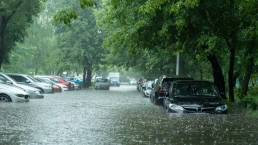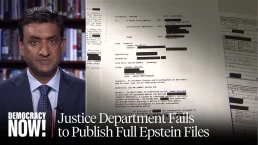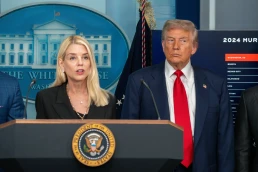The latest science on the link between climate change and natural disasters — and how they may be playing out where you live.
By Amal Ahmed, Grist
This is part of the Disaster 101 toolkit, a comprehensive guide to extreme weather preparation, response, and recovery.
Extreme weather seems to make the headlines almost every week, as disasters increasingly strike out of season, break records, and hit places they never have before.
Decades of scientific research has proven that human-caused climate change is making some disasters more dangerous and more frequent. The burning of fossil fuels like oil, gas, and coal releases carbon dioxide into the Earth’s atmosphere, where it traps heat, warms the planet, and alters the conditions in which extreme weather forms. These changes are happening more rapidly than at any time in the last 800,000 years, according to climate records.

Below, we break down what experts know — and what they don’t — about the connections between climate change and flooding.
Flooding is one of the most common natural disasters that can devastate a community. Between 2000 and 2019, nearly 1.6 billion people globally were impacted by floods, according to a study published in Nature.
In the U.S., the Federal Emergency Management Agency has been criticized for outdated and incomplete maps that severely underestimate the number of people living in areas with a high risk of flooding. In 2018, a study estimated 41 million Americans live within a 100-year flood zone, or a region with a 1 percent chance of flooding in any given year — over three times FEMA’s estimate of 13 million.
In 2023, for example, thousands of homes in Vermont flooded during a historic storm, and some that weren’t officially listed on any floodplain maps were inundated with 5 feet of water. Hurricane Harvey in 2017 flooded some 200,000 homes or businesses, including tens of thousands of structures not classified as being in the flood zone.
This undercount results in fewer people holding flood insurance policies than are actually at risk, leaving homeowners without financial support when disaster hits (regular home insurance does not cover floodwater). And because there are no federal requirements for a seller to disclose previous floods, potential home buyers might not even know they should have a policy.
Floods can happen almost anywhere — not just next to bodies of water. Heavy rain can cause rivers and even small creeks to overflow. Strong winds can create storm surges, causing ocean water to inundate coastal communities. In urban and suburban areas, flash flooding takes place when heavy rain can’t drain through paved, concrete surfaces; it pools in streets and overwhelms sewer systems.
Climate change is creating more extreme rainstorms, as warmer air can hold more moisture that will eventually come down as rain. Put another way: Earth “sweats” more as warmer air causes more water to evaporate and then condense and fall as rain. Models suggest that these storms can also stall for an extended period of time, deluging an area with more water than it can handle. Making matters worse, these storms can hit after extreme droughts and heat waves, a climate trend known as “weather whiplash.” When soil becomes hard and dry, it acts more like concrete, unable to soak up the excess water as effectively as it would in normal conditions.
The warming oceans are also affecting rainfall: The Gulf of Mexico’s waters supercharged Hurricane Helene, for example, which made landfall in Florida before quickly moving inland and dumping 40 trillion gallons of water across the Southeast and into Appalachia.
As rainfall becomes more extreme, experts have warned that existing flood control infrastructure won’t be adequate to protect communities in the future and is struggling under current conditions. The American Society of Civil Engineers’ annual infrastructure report card rates the nation’s dams, levees, and stormwater systems. This year, none of these categories received a grade above a D. These systems are in need of billions of dollars of repair and upgrades already, on top of the added stresses of climate change. In 2025, the Trump administration pulled funding for these types of projects as it reversed course from the previous administration’s climate goals, so many planned improvements are tied up in legal battles. Meanwhile, other projects being studied and planned aren’t factoring in the risks posed by climate change.
Below, we break down what experts know — and what they don’t — about the connections between climate change and flooding.
Flooding is one of the most common natural disasters that can devastate a community. Between 2000 and 2019, nearly 1.6 billion people globally were impacted by floods, according to a study published in Nature.
In the U.S., the Federal Emergency Management Agency has been criticized for outdated and incomplete maps that severely underestimate the number of people living in areas with a high risk of flooding. In 2018, a study estimated 41 million Americans live within a 100-year flood zone, or a region with a 1 percent chance of flooding in any given year — over three times FEMA’s estimate of 13 million.
In 2023, for example, thousands of homes in Vermont flooded during a historic storm, and some that weren’t officially listed on any floodplain maps were inundated with 5 feet of water. Hurricane Harvey in 2017 flooded some 200,000 homes or businesses, including tens of thousands of structures not classified as being in the flood zone.
This undercount results in fewer people holding flood insurance policies than are actually at risk, leaving homeowners without financial support when disaster hits (regular home insurance does not cover floodwater). And because there are no federal requirements for a seller to disclose previous floods, potential home buyers might not even know they should have a policy.
Floods can happen almost anywhere — not just next to bodies of water. Heavy rain can cause rivers and even small creeks to overflow. Strong winds can create storm surges, causing ocean water to inundate coastal communities. In urban and suburban areas, flash flooding takes place when heavy rain can’t drain through paved, concrete surfaces; it pools in streets and overwhelms sewer systems.
Climate change is creating more extreme rainstorms, as warmer air can hold more moisture that will eventually come down as rain. Put another way: Earth “sweats” more as warmer air causes more water to evaporate and then condense and fall as rain. Models suggest that these storms can also stall for an extended period of time, deluging an area with more water than it can handle. Making matters worse, these storms can hit after extreme droughts and heat waves, a climate trend known as “weather whiplash.” When soil becomes hard and dry, it acts more like concrete, unable to soak up the excess water as effectively as it would in normal conditions.
The warming oceans are also affecting rainfall: The Gulf of Mexico’s waters supercharged Hurricane Helene, for example, which made landfall in Florida before quickly moving inland and dumping 40 trillion gallons of water across the Southeast and into Appalachia.
As rainfall becomes more extreme, experts have warned that existing flood control infrastructure won’t be adequate to protect communities in the future and is struggling under current conditions. The American Society of Civil Engineers’ annual infrastructure report card rates the nation’s dams, levees, and stormwater systems. This year, none of these categories received a grade above a D. These systems are in need of billions of dollars of repair and upgrades already, on top of the added stresses of climate change. In 2025, the Trump administration pulled funding for these types of projects as it reversed course from the previous administration’s climate goals, so many planned improvements are tied up in legal battles. Meanwhile, other projects being studied and planned aren’t factoring in the risks posed by climate change.
Recent Posts
The “President Of Peace” Prepares For War
December 23, 2025
Take Action Now The Donroe Doctrine Hits HomeBy William D. Hartung, Tom Dispatch Earlier this month, the Trump administration released its new…
“Who Are They Protecting?”: Rep. Ro Khanna Urges Contempt Charges Over AG Bondi’s Epstein Redactions
December 22, 2025
Take Action Now “The House can act unilaterally on contempt, and this will be introduced by Thomas Massie. What the resolution will say is that…
Dems Demand Answers as Trump Photo Disappears From DOJ Online Epstein Files
December 21, 2025
Take Action Now “What else is being covered up?”By Brett Wilkins, Common Dreams Congressional Democrats on Saturday pressed US Attorney General…
Elon Musk Is Vowing Utopia Driven by AI and Robotics. Bernie Sanders Has a Few Questions
December 20, 2025
Take Action Now “I look forward to hearing about how you and your other oligarch friends are going to provide working people with a magnificent life…




